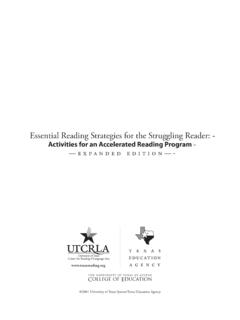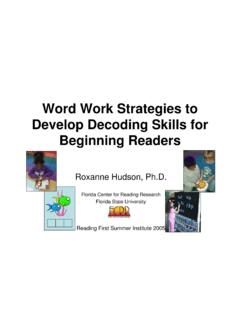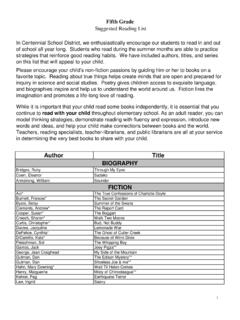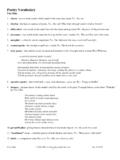Transcription of Reading Fluency: Tasks, Texts, and Teaching
1 Reading Fluency: Tasks, Texts, and TeachingWhatWhat s All the Fuss About?s All the Fuss About?General Research FindingsFluent Reading , like the thread of life itself Fluent Reading , like the thread of life itself ((KendrewKendrew, 1966), is intrinsically elegant in , 1966), is intrinsically elegant in both form and cadenceboth form and certainly know We certainly know it when we see it, and we are quick to it when we see it, and we are quick to celebrate it, along with the trajectory of celebrate it, along with the trajectory of success it it portends. Kame neui, , & Simmons, (2001). The DNA of Reading Fluency. Scientific Studies of Reading , 5(3), Research history of fluency research in the field of The history of fluency research in the field of Reading might be characterized as Reading might be characterized as intellectually spasmodic: There are periods of intellectually spasmodic: There are periods of great effort and creativity, followed by fallow great effort and creativity, followed by fallow periods of relative disinterest.
2 In 1983 periods of relative disinterest. In 1983 fluency was described as the fluency was described as the most neglectedmost neglected Reading skill (Allington,1983). Reading skill (Allington,1983).Wolf, M. and Katzir-Cohen, T. (2001). Reading fluency and its intervention. Scientific Studies of Reading , 5(3), Research Findingscont. Skilled readers can read words in context Skilled readers can read words in context threethreetimes times faster and read words in lists faster and read words in lists twotwotimes faster than times faster than can struggling readers. can struggling readers. With this distribution of fluency in a classroom With this distribution of fluency in a classroom whole class instruction and singular approaches will whole class instruction and singular approaches will not be likely to meet the needs of all children.
3 Not be likely to meet the needs of all children. Struggling readers are slower because of problems in Struggling readers are slower because of problems in list list Reading as context doesnreading as context doesn t make any unique t make any unique contribution to fluency rates and to fluency rates and , , Fuchs, L. S., Van den Broek, P., Espin, C., & Deno. S. L. (2003) Accuracy and fluency in list and context Reading of skilled and RD groups: Absolute and relative performance levels. Learning Disabilities Research and Practice, 18 (4), Research words make up 33% of the words you read!25 words make up 33% of the words you read!ThorndikeThorndike--LorgeLorgemagaz ine count. Ed. Thorndike & I. magazine count. Ed. Thorndike & I.
4 LorgeLorge. New York, 1944: Columbia [entries from "The teacher's w. New York, 1944: Columbia [entries from "The teacher's word book of 30,000 ord book of 30,000 words "; on RLIN] words "; on RLIN]General Research Findingscont. 107 words make up over 50% of the words you read!107 words make up over 50% of the words you read! 930 words make up 65% of the words you read!930 words make up 65% of the words you read! 5,000 words make up 80% of the words you read?5,000 words make up 80% of the words you read? 13% of words occur only once in one million words13% of words occur only once in one million wordsZeno, S. M., Zeno, S. M., IvensIvens, S. H., Millard, , & , S. H., Millard, , & DuvvuriDuvvuri, R. (1995). The educator, R. (1995). The educator s word guide.
5 New s word guide. New York: Touchstone Applied Science Associates, : Touchstone Applied Science Associates, , E. H. (2004). Texts for Fluency and Vocabulary: Selecting Inst, E. H. (2004). Texts for Fluency and Vocabulary: Selecting Instructional Texts that ructional Texts that Support Reading Fluency Support Reading Fluency General Research Findingscont. 44% of American Fourth Graders 44% of American Fourth Graders cannot read fluently, even when they cannot read fluently, even when they read graderead grade--level stories aloud under level stories aloud under supportive testing testing conditions. By Fourth Grade most children are By Fourth Grade most children are fairly accurate but also very accurate but also very , , Pinnell, , PikulskiPikulski, , , , WixsonWixson, , Campbell, , Gough, , & Beatty, (1995).
6 List, , Campbell, , Gough, , & Beatty, (1995). Listening to ening to children read aloud: Oral fluency. Washington, DC: National Cenchildren read aloud: Oral fluency. Washington, DC: National Center for Educational Statistics, ter for Educational Statistics, Department of of Research Findingscont. Context Reading fluency is highly dependent upon word-recognition skills as well as the context. Skilled readers do not rely upon context to predict or recognize words as do poorer readers. Context-free or word-recognition Reading skill helps poorer readers fluency while comprehension processes help skilled readers , , Fuchs, L. S., Van den Jenkins, , Fuchs, L. S., Van den BroekBroek, P., , P., EspinEspin, C., & , C., & DenoDeno.
7 S. L. (2003). Sources of individual . S. L. (2003). Sources of individual differences in Reading comprehension and Reading fluency. Journadifferences in Reading comprehension and Reading fluency. Journal of Educational Psychology, 95(4), l of Educational Psychology, 95(4), , K. (1980). Toward an interactive, K. (1980). Toward an interactive--compensatory model of individual differences in the development compensatory model of individual differences in the development of Reading fluency. Reading Research Quarterly, 16(1), 37of Reading fluency. Reading Research Quarterly, 16(1), Research Findingscont. Letter naming fluency uniquely predicts 1stgrade oral Reading fluency more so than does letter-sound , S., Sheppard, J., Davidson, M.
8 M., & Browning, M. M. (2001). Prediction of first-graders growth in oral Reading fluency using kindergarten letter fluency. Journal of School Psychology, 39 (3), Research Findingscont. Effective fluency lessons include practice and explicit instruction. Fluency practice is effectively accomplished using a variety of grouping strategies and methods such as whole class readings, performance, oral repeated readings, buddy or paired Reading , assisted Reading , closed caption TV, , J., & Broaddus, K. (2002). The Reading Teacher, 55(4), 3 Worthy, J., & Broaddus, K. (2002). The Reading Teacher, 55(4), , J., & Prater, K. (2002). The Reading Teacher, 56(3), 294 Worthy, J., & Prater, K. (2002). The Reading Teacher, 56(3), Research Findingscont.
9 Word recognition automaticity is achieved through practice because practice provides successive exposures to print. Practice doesn t fully explain how prosody develops. Prosody may be the link between fluency and comprehension because it provides cues to an otherwise invisible process. There are many unresolved issues and questions about text difficulty, practice conditions, time allocation, self monitoring, oral vs. silent, , , & Stahl, S. A. (2000). Fluency: A review of developmKuhn, , & Stahl, S. A. (2000). Fluency: A review of developmental and remedial practices. ental and remedial practices. Ann Arbor, MI: Center for the Improvement of Early Reading AchieAnn Arbor, MI: Center for the Improvement of Early Reading : A Definition/ essential ComponentsAccuracy and Automaticity of Decoding Processes Readers decode words accurately Readers decode words effortlesslyReading Speed or Rate Readers read with an age or grade level appropriate rate Reading speed is adjusted for purpose and text difficultyExpression and Prosody Readers read with smoothness, phrasing, and Readers comprehend important ideas inFluency: Tasks Fluent letter recognition Fluent word recognition Fluent word decoding Fluent Reading of connected textthethetheFluency.
10 Task Considerations Fluent letter recognition Name Produce SearchRemember that fluent letter recognition predicts early Reading achievement!Fluency: Tasks Fluent word recognition Focus on High Frequency words Recognize (Say) Produce (Write) Search (Find) Focus on Highly Useful Word Patterns Recognize (Say) Produce (Write) Search (Find)thethetheFluency: Tasks Fluent word recognition Focus on High Frequency words Fry Instant words First 100 Fry, , Kress, , Fry, , Kress, , FountoukidisFountoukidis, D. L. (2000). The Reading Teacher, D. L. (2000). The Reading Teacher s Book s Book of lists , 4of lists , 4ththEdition. Paramus, NJ: Prentice Paramus, NJ: Prentice : Tasks Fluent word recognition Focus on Highly Useful Word Patterns Adams, M.














